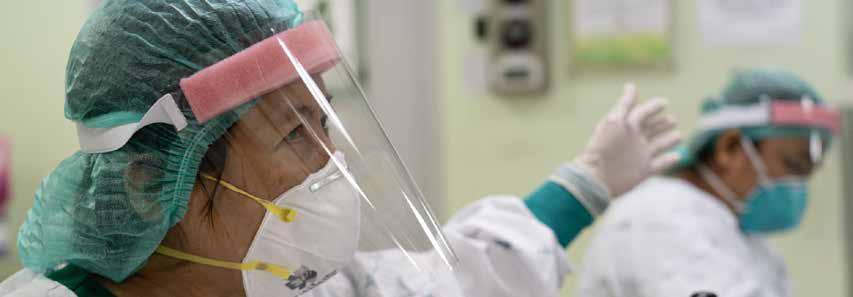
2 minute read
Maternal Health Initiative
3 20 things to watch: MATERNAL HEALTH
1
COVID-19 and the Healthcare Workforce
The World Health Organization has declared 2020 as the International Year of the Nurse and the Midwife. Globally, 27.9 million nurses and 2 million midwives work at the front lines of health care systems and currently work side-by-side with other first responders to battle the spread of COVID-19. Nurses and midwives make up 59 percent of the global health workforce. The health sector uniquely employs more women than any other sector—in fact, approximately 70 percent of the global health workforce and 90 percent of nurses are women. As such, nursing remains a highly gendered profession, with associated biases. Nurses and midwives have demanded proper personal protection equipment and resources in their fight against the novel coronavirus. Some health providers lost their jobs because they demanded safe working conditions before treating patients, while others lost their lives because they did not.
Featured Experts:
Sarah Barnes, Project Director, Maternal Health Initiative
http://www.wilsoncenter.org/maternalhealth MHI@wilsoncenter.org Facebook.com/ecspwwc @Wilson_MHI 202.691.4292
years years
2
COVID-19: Magnifying the World’s Inequities and Gender Dimensions

Early reports described COVID-19 as “the Great Equalizer,” spreading around the globe and infecting everyone in its path, regardless of income, race, or gender. Current reporting, however, points to a different reality: COVID-19 disproportionately infects and kills African Americans and Latinx populations in the United States and immigrants worldwide, while women and girls suffer not only from the infection itself but also from the elevated risks of gender-based violence and restrictive social norms associated with the response. Experts predict that women’s independence will be a silent victim to COVID-19, possibly putting women’s achievements and advancements back decades. Girls are out of school and, for some, returning will be nearly impossible as their families come to rely on their domestic contributions and as adolescent pregnancy rates increase. As the total number of COVID-19 cases continues to climb, policymakers are faced with a devastating number of possible outcomes. One outcome that history has proven time and again to be certain is that the hardest hit will be the world’s women and girls and those populations already affected by racism and discrimination. In response, policymakers are undertaking a comprehensive analysis of impact, to ensure marginalized populations are central in responses efforts.
3

The emergency response to the COVID-19 pandemic ultimately means that resources and services previously allocated to reproductive, maternal, and newborn health services will be diverted to slow the spread of COVID-19. As a result, there will be more maternal and newborn deaths, more unmet needs for contraception, more unsafe abortions, and more sexually transmitted infections. Access to family planning and other sexual and reproductive health commodities are central to women’s health, empowerment, and sustainable development. Pregnant women with COVID-19 must be prioritized, especially those with respiratory illnesses or existing non-communicable diseases, and their newborns should be monitored. The implications of COVID-19 for pregnant women and newborns remain greatly unknown, making it essential to obtain accurate and up-to-date data and engage in research efforts to save the lives of women and newborns.










